The lithium battery is mainly composed of a positive electrode active material, a negative electrode active material, an electrolyte solution and a separator. The negative electrode active material is usually made of a carbon material, and the positive electrode material mainly has a lithium-based material.
As the world's environmental problems intensify, the state and enterprises have accelerated the pace of human society turning to a clean and energy-saving society. Among them, the development of electric vehicles has contributed to the fresh air and reduced carbon emissions, occupying an important position in the new energy industry. At present, domestic car companies are accelerating the deployment of power batteries, and downstream demand is forcing higher and higher requirements for materials and processes for power batteries. The lithium battery is mainly composed of a positive electrode active material, a negative electrode active material, an electrolyte solution and a separator. The negative electrode active material is usually made of a carbon material, and the positive electrode material mainly has a lithium-based material. Then, what kind of development stage of lithium-containing minerals as the upstream raw material of the cathode material, and what developments in the lithium ore extraction process?
I. Overview of the development of the lithium industry
Supply and demand requirements are the core content of the product. According to the development of the lithium industry in the past two years, it will continue to maintain rapid development for a period of time. According to relevant data, the overall supply and demand of the industry in 2017-2018 and even in the first half of 2019 is still in a state of tight balance. From the historical experience, the existing lithium resource production is easy to be disturbed by climate and traffic, and the development of new resources is difficult, the stability is also doubtful, and the probability of a shortage of supply in stages is still relatively large.
Second, lithium mineral extraction process
There are more than one hundred kinds of lithium-containing minerals in the mineral field, but among the rich and high-grade lithium minerals, spodumene and lithium mica are the most. The distribution of lithium resources in China is as follows:
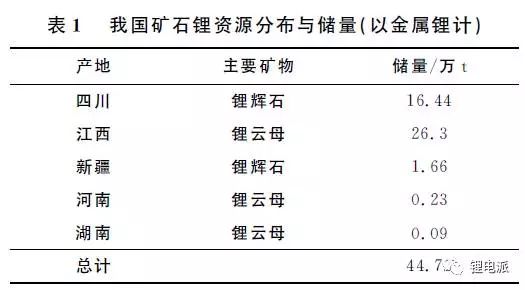
(1) Lithium fluorite
The lithium oxide content in the spodumene concentrate is about 5.0% to 8.5%. At present, the lithium-extracted lithium spodumene product is mainly lithium carbonate, and the processes thereof mainly include a sulfuric acid production process, a sulfate mixed sintering process, a sodium chloride roasting production process, a sodium carbonate pressure leaching production process, and a limestone roasting production process. The following is a brief introduction to the main production processes.
1 sulfuric acid process
The sulfuric acid process is commonly used in industrial production. After the lithium ore is subjected to grinding-baking-leaching, the sulfate is removed by filtration to obtain a lithium sulfate solution. The precipitated lithium carbonate was prepared using this solution, and then washed and dried to obtain a product. The method has a high yield and does not require high grades for lithium ore. The sulfuric acid process can also handle lithium mica.
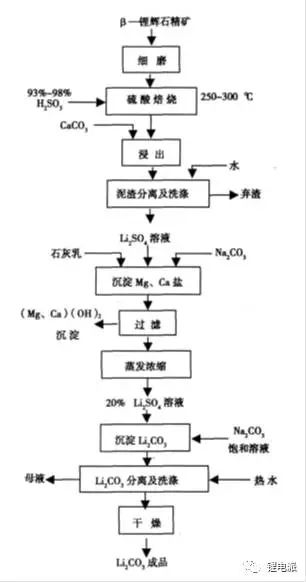
2 sulfate mixed sintering method
The spodumene concentrate and K2SO4 (or CaSO4 or a mixture of the two) are mixed and sintered at a certain temperature. After a series of physical and chemical reactions, the metal elements in the sulfated salt replace the lithium in the ore to form a soluble solution. Sulfate, the main impurities form a poorly soluble compound, and then the sinter clinker is leached and separated, lithium ions enter the solution, purified, concentrated, and precipitated to obtain a lithium carbonate product.
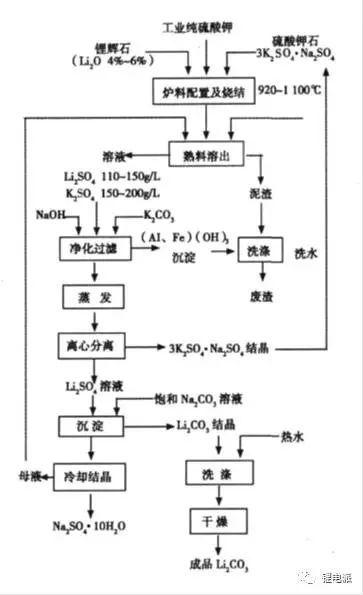
3 sodium carbonate pressure leaching method
Firstly, the β-spodumene obtained by the processing of spodumene is ground to a certain degree of fineness, and a certain amount of sodium carbonate is added to be mixed, and the mixture is leached at 200 ° C in a reactor, and then CO 2 gas is introduced to form soluble hydrogen carbonate. The lithium solution is filtered to remove the residue (zeolite), heated to 95 ° C to eject CO 2 , precipitated, filtered, and the filter cake is dried to obtain a lithium carbonate product.
4 limestone roasting method
Limestone roasting process for the treatment of lithium-containing minerals to produce lithium carbonate, the production process includes raw material preparation, roasting, leaching, washing slag, leaching solution concentration, purification, crystallization and other major processes. The main advantage of the lime method is that it is very practical because it is suitable for decomposing almost all lithium minerals. The reaction process does not require scarce reagents.
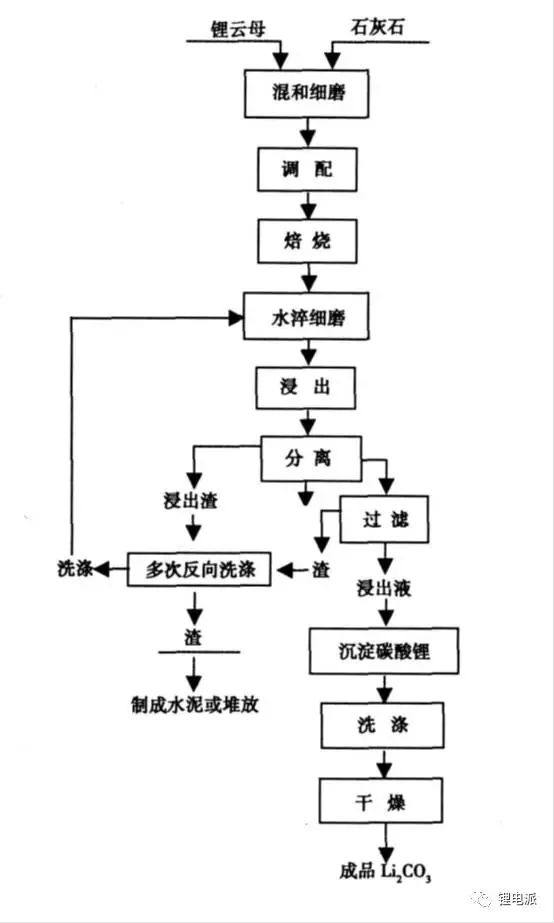
(2) Lithium mica lithium extraction
China has abundant lithium mica resources. The lithium oxide content in lithium mica concentrate is about 2.0% to 5.0%. The lithium mica resources in Yichun, Jiangxi are relatively concentrated, the mining conditions are superior, and it contains expensive cesium, strontium resources and a large amount of valuable. Resources aluminum, potassium and fluorine. At present, the lithium extraction process of lithium mica mainly includes limestone sintering method, sulfate baking method, sodium chloride pressing method, sodium sulfate pressing method, lime pressing method and the like.
1 limestone sintering method
The limestone sintering process is similar to the lithium pyroxene lithium extraction process, which is the most mature method. The advantages of this method are outstanding: (1) The leaching process is short. (2) The leaching system is good, it is an alkaline system, and the equipment is less corroded. (3) The separation process of lithium hydroxide is simple, and the yield of potassium, strontium and barium is high. At the same time, its disadvantages are low yield, large slag volume and high energy consumption.
2 sulfate roasting method
The sulphate roasting method has less slag production and lower energy consumption. The yield is about 10% higher than the limestone sintering method. However, the use of this method leads to a long time for removing impurities and a cumbersome process. When the sulfate is a potassium salt, all the lithium ore is applied, but the potassium salt is relatively expensive and the cost is high.
3 sodium chloride boiling method
The process of sodium chloride pressing is relatively simple, similar to the limestone method, and the amount of slag is very small. The yield of lithium can reach 80%. Due to the chlorine-containing system used, the corrosion of the equipment is relatively large, so the requirements for the equipment are relatively high.
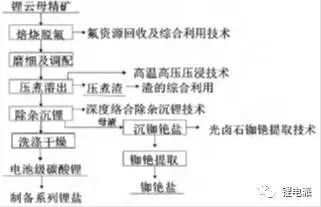
In addition, a process such as a sulfuric acid method or a chlorination roasting method is used to carry out lithium extraction of lithium mica. Lithium mica is a very complex substance. In general, how to improve the lithium mica grade, reduce the slag amount in the leaching process and the separation process, and enter the liquid phase into the liquid phase as much as possible during the leaching process and economically separate them. The process flow is as short as possible, and the corrosion problem of the equipment can be handled at the same time. The lithium mica lithium extraction process should be considered.
Third, the conclusion
After decades of research on lithium extraction from lithium ore, China's lithium industry has made tremendous achievements in technology. For lithium ore, the yield of lithium has increased from 60% to over 80%, and the amount of slag and energy consumption have been further reduced, which has contributed greatly to the development of lithium battery industry in China. In addition, new technologies such as lithium extraction from salt lakes play an irreplaceable role. In the future, China's technology for extracting lithium from minerals and extracting lithium from salt lakes will become more and more perfect, improve the comprehensive utilization efficiency of minerals, change from a rough development mode to fine processing, and efficiently use resources for every industrial, mining, and earth. Responsibilities and obligations. Let us build the earth better!
Android is an open source mobile operating system based on Linux platform released by Google at the end of 2007, and then improved for use in netbooks and MIDs. The platform consists of operating system, user interface and application software, and is claimed to be the first truly open and complete mobile software for mobile terminals.
To put it simply, the Android system is actually a very open system. It can not only realize the functions of the most commonly used notebook computers, but also realize various directional operations like mobile phones. Moreover, it is specially designed for mobile phones. The operating system developed for equipment has advantages in system resource consumption and human-computer interaction design. It is an operating system that combines traditional and advanced advantages.
New Android Tablet,Android Tablet,New Android Tablet
Jingjiang Gisen Technology Co.,Ltd , https://www.jsgisentec.com